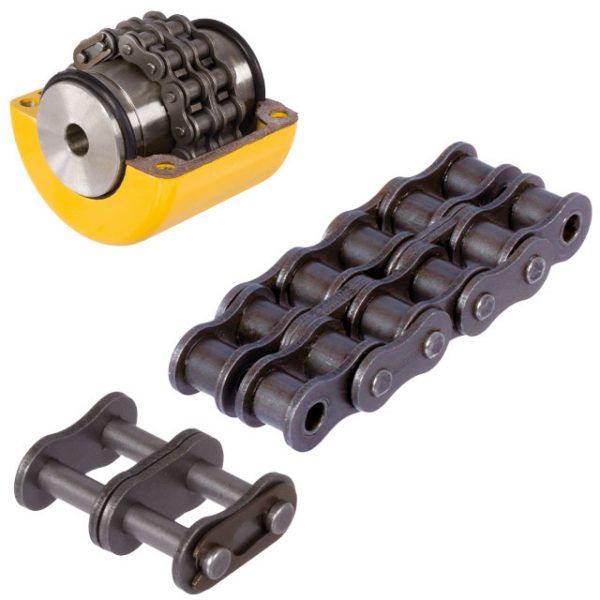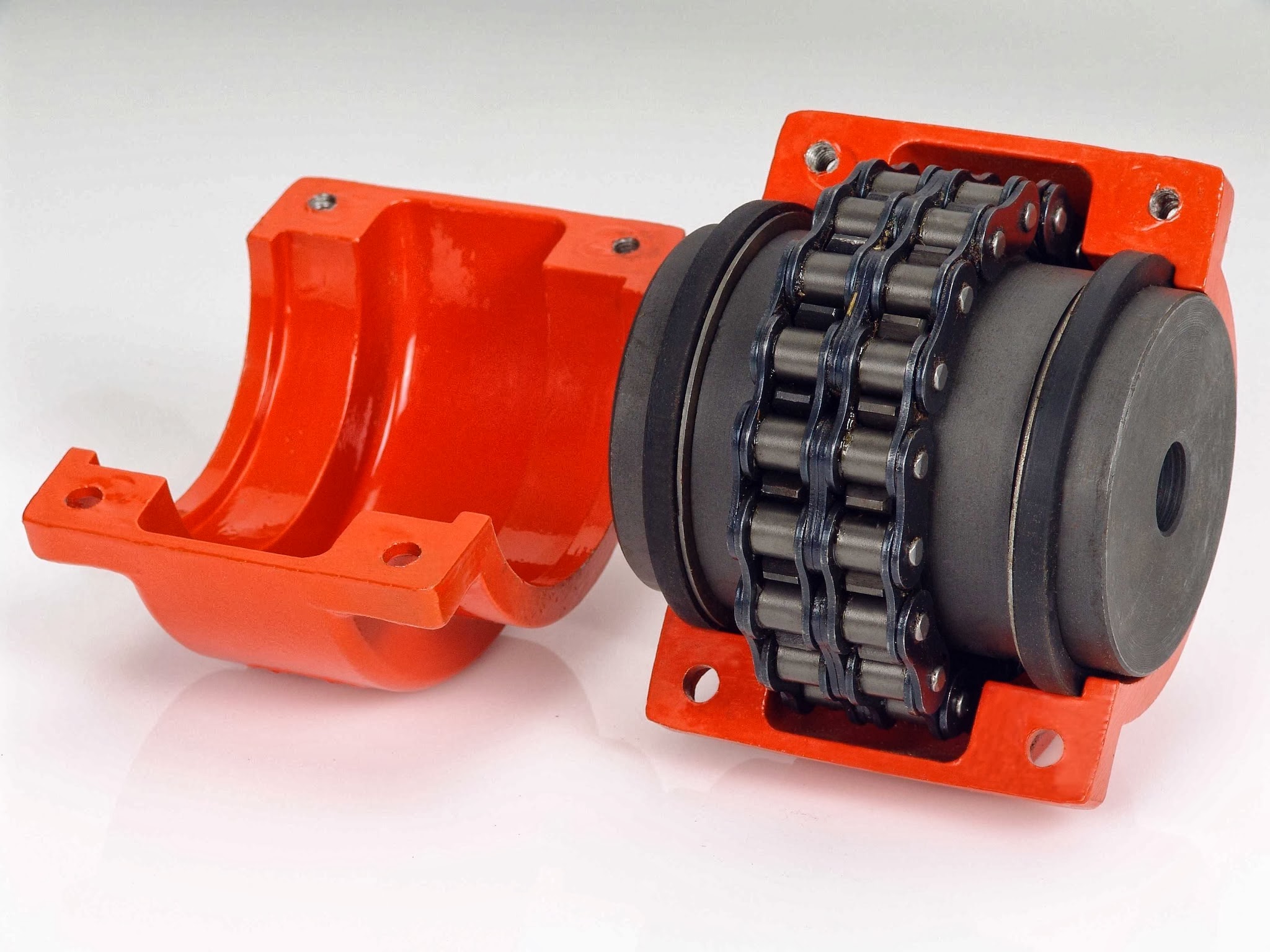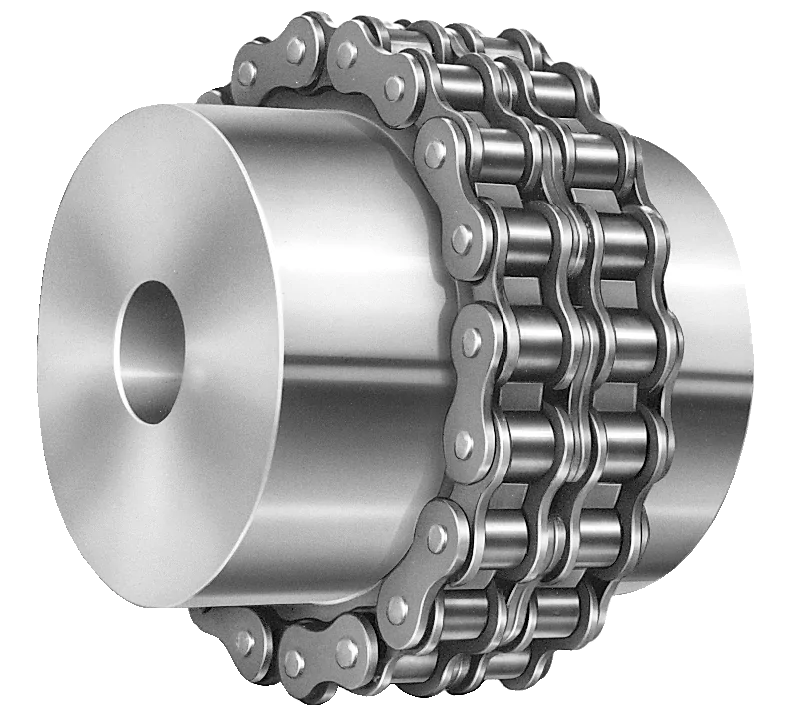Product Description
Product Description
Roller chain couplings have the advantages of simple structure, convenient loading and unloading, large torque transmission, and easy operation. However, there is significant wear between the chains, especially during high-speed operation when the radial motion generated by centrifugal force will accelerate their wear. Therefore, it is not suitable for use at high speeds and under impact loads, nor for the connection of vertical shafts.
When designing the overall structure of the coupling, full attention should be paid to the lubrication and dust prevention between the tooth surface and the rollers, and an outer shell should be added. In addition to dust and oil storage, it also has a protective effect. Because if the chain breaks, it may cause personal accidents.
The double row sleeve roller chain coupling has formed a standard (old standard GB6069-85, new standard GB/T 6069-2002). The transmission torque and allowable speed are 4 times and 2 times that of a single row roller chain of the same size, respectively. Because when the chain size is determined, it can accommodate 2 teeth within the width of a single row of sleeve rollers, while a double row can only accommodate 1 tooth, the tooth thickness of a single row is only half of that of a double row. So, the rollers of the double row chain are located in the grooves of the main and driven sprockets, and when subjected to force, they rotate independently without interfering with each other, reducing wear.
Product Parameters
| model | Nominal torqueTnN·m | Allowable speed(n) r/min | Axis hole diameter d1,d2 | Axis hole length | Chain number | chain Pitch | Number of teeth Z | D | b1 | S | A | Dx () | Lx () | kg | Transmission inertiakg·m2 | ||
| Ymodel | J1model | ||||||||||||||||
| No cover installed | Installing cover | L | L1 | ||||||||||||||
| GL1 | 40 | 1400 | 4500 | 16 | 42 | – | 06B | 9.525 | 14 | 51.06 | 5.3 | 4.9 | – | 70 | 70 | 0.40 | 0.0571 |
| 18 | 42 | – | – | ||||||||||||||
| 19 | 42 | – | – | ||||||||||||||
| 20 | 52 | 38 | 4 | ||||||||||||||
| GL2 | 63 | 1250 | 4500 | 19 | 42 | – | 06B | 9.525 | 16 | 57.08 | 5.3 | 4.9 | – | 75 | 75 | 0.70 | 0.0571 |
| 20 | 52 | 38 | 4 | ||||||||||||||
| 22 | 52 | 38 | 4 | ||||||||||||||
| 24 | 52 | 38 | 4 | ||||||||||||||
| GL3 | 100 | 1000 | 4000 | 20 | 52 | 38 | 08B | 12.7 | 14 | 68.88 | 7.2 | 6.7 | 12 | 85 | 80 | 1.1 | 0.00038 |
| 22 | 52 | 38 | 12 | ||||||||||||||
| 24 | 52 | 44 | 12 | ||||||||||||||
| 25 | 62 | – | 6 | ||||||||||||||
| GL4 | 160 | 1000 | 4000 | 24 | 52 | – | 08B | 12.7 | 16 | 76.91 | 7.2 | 6.7 | – | 95 | 88 | 1.8 | 0.0 |
| 25 | 62 | 44 | 6 | ||||||||||||||
| 28 | 62 | 44 | 6 | ||||||||||||||
| 30 | 82 | 60 | – | ||||||||||||||
| 32 | 82 | 60 | – | ||||||||||||||
| GL5 | 250 | 800 | 3150 | 28 | 62 | – | 10A | 15.875 | 16 | 94.46 | 8.9 | 9.2 | – | 112 | 100 | 3.2 | 0.0571 |
| 30 | 82 | 60 | – | ||||||||||||||
| 32 | 82 | 60 | – | ||||||||||||||
| 35 | 82 | 60 | – | ||||||||||||||
| 38 | 82 | 60 | – | ||||||||||||||
| 40 | 112 | 84 | – | ||||||||||||||
| GL6 | 400 | 630 | 2500 | 32 | 82 | 60 | 10A | 15.875 | 20 | 116.57 | 8.9 | 9.2 | – | 140 | 105 | 5.0 | 0.0058 |
| 35 | 82 | 60 | – | ||||||||||||||
| 38 | 82 | 60 | – | ||||||||||||||
| 40 | 112 | 84 | – | ||||||||||||||
| 42 | 112 | 84 | – | ||||||||||||||
| 45 | 112 | 84 | – | ||||||||||||||
| 18 | 112 | 84 | – | ||||||||||||||
| 50 | 112 | 84 | – | ||||||||||||||
| GL7 | 630 | 630 | 2500 | 40 | 112 | 60 | 12A | 19.05 | 18 | 127.78 | 11.9 | 10.9 | – | 150 | 122 | 7.4 | 0.012 |
| 42 | 112 | 60 | – | ||||||||||||||
| 45 | 112 | 60 | – | ||||||||||||||
| 48 | 112 | 84 | – | ||||||||||||||
| 50 | 112 | 84 | – | ||||||||||||||
| 55 | 112 | 84 | – | ||||||||||||||
| 60 | 142 | 107 | – | ||||||||||||||
| GL8 | 1000 | 500 | 2240 | 45 | 112 | 84 | 16A | 25.40 | 16 | 154.33 | 15.0 | 14.3 | 12 | 180 | 135 | 11.1 | 0.571 |
| 48 | 112 | 84 | 12 | ||||||||||||||
| 50 | 112 | 84 | 12 | ||||||||||||||
| 55 | 112 | 84 | 12 | ||||||||||||||
| 60 | 142 | 107 | – | ||||||||||||||
| 65 | 142 | 107 | – | ||||||||||||||
| 70 | 142 | 107 | – | ||||||||||||||
| GL9 | 1600 | 400 | 2000 | 50 | 112 | 84 | 16A | 25.4 | 20 | 186.50 | 15.0 | 14.3 | 12 | 215 | 145 | 20.0 | 0.061 |
| 55 | 112 | 84 | 12 | ||||||||||||||
Packaging & Shipping
After Sales Service
If during transportation or if the customer receives the goods, opens the packaging and finds any damage, they can resend a new product to the customer.
/* January 22, 2571 19:08:37 */!function(){function s(e,r){var a,o={};try{e&&e.split(“,”).forEach(function(e,t){e&&(a=e.match(/(.*?):(.*)$/))&&1

Can chain couplings be used in high-speed applications?
Chain couplings can be used in certain high-speed applications, but there are limitations and considerations that need to be taken into account. The suitability of chain couplings for high-speed applications depends on factors such as the specific design of the coupling, the chosen chain type, and the operating conditions. Here are some key points to consider:
- Coupling Design: The design of the chain coupling plays a crucial role in determining its suitability for high-speed applications. High-speed chain couplings typically incorporate features that minimize vibration, reduce stress concentrations, and ensure smooth operation. Couplings designed for high-speed use may have additional balancing or damping mechanisms to counteract potential issues associated with centrifugal forces and resonance.
- Chain Type: The type of chain used in the coupling can affect its performance at high speeds. In general, roller chains are commonly used in chain couplings. However, for high-speed applications, special high-speed roller chains or other chain types designed for increased rotational speeds may be required. These chains are designed to minimize friction, reduce wear, and handle the centrifugal forces associated with high-speed operation.
- Bearing Selection: Proper bearing selection is critical for high-speed chain couplings. The bearings used in the coupling should be capable of handling the anticipated speeds and dynamic loads. High-quality, precision bearings with appropriate lubrication are typically necessary to ensure smooth operation and minimize the risk of premature failure.
- Balancing and Vibration: High-speed chain couplings should be properly balanced to minimize vibration and ensure stable operation. Imbalances in rotating components can lead to increased noise, excessive stress, and reduced service life. Balancing techniques such as dynamic balancing or the use of counterweights may be employed to achieve smooth and reliable operation.
- Lubrication: Adequate lubrication is crucial for high-speed chain couplings to minimize friction, reduce wear, and dissipate heat effectively. Proper lubrication practices, including the use of high-quality lubricants and regular maintenance, should be followed to ensure optimal performance and prevent premature failure.
Despite these considerations, it’s important to note that chain couplings may have practical limitations in terms of maximum allowable speeds. The specific speed limitations will depend on factors such as the coupling design, chain type, size, and the operating conditions. It is advisable to consult the manufacturer’s specifications and guidelines to determine the maximum recommended speed for a particular chain coupling.
In certain high-speed applications where chain couplings may not be suitable, alternative coupling types such as flexible disc couplings, gear couplings, or elastomeric couplings specifically designed for high-speed applications may be more appropriate. These couplings are engineered to handle the challenges associated with high rotational speeds, offering improved balance, reduced vibration, and higher speed capabilities.
Overall, when considering the use of chain couplings in high-speed applications, it is essential to carefully evaluate the specific requirements, consult with the manufacturer, and ensure that the coupling is designed and selected to operate safely and reliably at the desired speeds.

What are the key components of a chain coupling?
A chain coupling consists of several key components that work together to transmit power and accommodate misalignments. Here are the main components of a chain coupling:
- Sprockets: Sprockets are the toothed wheels that engage with the chain. They are typically made of steel or other durable materials and have specially designed teeth that mesh with the chain rollers. The sprockets provide the driving and driven connections, transmitting torque from one shaft to another.
- Roller Chain: The roller chain is a series of interconnected links with rollers between them. It is looped around the sprockets, with the rollers engaging with the sprocket teeth. The roller chain transfers the rotational motion from the driving sprocket to the driven sprocket, allowing power transmission between the shafts.
- Connecting Pins: Connecting pins are used to join the links of the roller chain together, forming a continuous loop. These pins are inserted through the pin holes in the chain links and secured with retaining clips or other fasteners. They ensure the integrity and strength of the chain.
- Bushings or Bearings: Bushings or bearings are used to support the shafts and allow them to rotate smoothly within the chain coupling. They are typically inserted into the bores of the sprockets and provide a low-friction interface between the shaft and the coupling components.
- Guard or Cover: In some chain couplings, a guard or cover is added to enclose the sprockets and chain. This serves as a protective barrier, preventing contact with moving parts and reducing the risk of accidents or injuries. The guard or cover also helps to contain lubrication and protect the chain from contaminants.
- Lubrication: Lubrication is essential for the smooth operation and longevity of a chain coupling. Proper lubrication reduces friction, wear, and noise. Lubricants, such as chain oil or grease, are applied to the chain and sprockets to minimize frictional losses and prevent premature wear.
These components work together to provide a reliable and efficient power transmission in chain couplings. The sprockets engage with the roller chain, and as one sprocket rotates, it drives the chain, causing the other sprocket and the connected shaft to rotate. The roller chain and its components, along with lubrication, allow for flexibility and compensation of misalignment between the shafts.

What is a chain coupling?
A chain coupling is a mechanical device used to connect two rotating shafts in a power transmission system. It consists of two sprockets or toothed wheels and a roller chain that meshes with the sprocket teeth. The sprockets are mounted on the respective shafts and linked together by the chain, allowing torque to be transmitted from one shaft to the other.
Chain couplings are designed to provide a flexible and reliable connection between shafts while accommodating misalignment between them. They are known for their ability to compensate for angular, parallel, and axial misalignments, making them suitable for a wide range of industrial applications.
The sprockets of a chain coupling typically have hardened teeth that engage with the rollers of the chain. The chain itself is made up of a series of interconnected links, each consisting of two plates joined by pins. The rollers are mounted on the pins, allowing them to rotate freely and mesh with the sprocket teeth.
One of the key advantages of chain couplings is their ability to transmit high torque loads. The engagement between the sprockets and the chain provides a positive drive, allowing for efficient power transfer even in demanding applications. Chain couplings are commonly used in heavy-duty machinery and equipment where large amounts of power need to be transferred, such as conveyors, mixers, crushers, and industrial drives.
Chain couplings also offer flexibility in shaft alignment. They can compensate for angular misalignment, which occurs when the shafts are not perfectly aligned at an angle. Additionally, they can accommodate parallel misalignment, where the shafts are offset from each other, as well as axial misalignment, which refers to the displacement along the axis of the shafts.
Proper lubrication is essential for the efficient operation and longevity of chain couplings. Lubricants such as oil or grease are applied to the chain and sprockets to reduce friction and wear. This helps to prevent heat buildup and ensures smooth rotation and power transmission.
Chain couplings are available in various sizes, configurations, and materials to suit different application requirements. The selection of a chain coupling depends on factors such as torque capacity, speed, shaft diameter, and misalignment tolerance.
In summary, chain couplings provide a flexible, reliable, and high-torque solution for connecting rotating shafts in power transmission systems. They offer the ability to compensate for misalignment, making them suitable for a wide range of industrial applications where efficient power transfer is crucial.


editor by CX 2024-04-24
